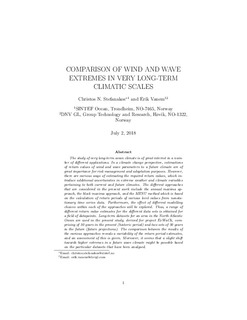| dc.contributor.author | Stefanakos, Christos | |
| dc.contributor.author | Vanem, Erik | |
| dc.date.accessioned | 2018-09-29T15:25:07Z | |
| dc.date.available | 2018-09-29T15:25:07Z | |
| dc.date.created | 2018-09-27T15:31:26Z | |
| dc.date.issued | 2018-06-17 | |
| dc.identifier.citation | ASME 2018 37th International Conference on Ocean, Offshore and Arctic Engineering - Volume 7B: Ocean Engineering | nb_NO |
| dc.identifier.isbn | 978-0-7918-5127-2 | |
| dc.identifier.uri | http://hdl.handle.net/11250/2565303 | |
| dc.description.abstract | The study of very long-term ocean climate is of great interest in a number of different applications. In a climate change perspective, estimations of return values of wind and wave parameters to a future climate are of great importance for risk management and adaptation purposes. However, there are various ways of estimating the required return values, which introduce additional uncertainties in extreme weather and climate variables pertaining to both current and future climates. The different approaches that are considered in the present work include the annual maxima approach, the block maxima approach, and the MENU method which is based on the calculation of return periods of various level values from nonstationary time series data. Furthermore, the effect of different modelling choices within each of the approaches will be explored. Thus, a range of different return value estimates for the different data sets is obtained for a field of datapoints. Long-term datasets for an area in the North Atlantic Ocean are used in the present study, derived for project ExWaCli, comprising of 30 years in the present (historic period) and two sets of 30 years in the future (future projections). The comparison between the results of the various approaches reveals a variability of the return period estimates, and an assessment of this is given. Moreover, it seems that a slight shift towards higher extremes in a future wave climate might be possible based on the particular datasets that have been analysed. | nb_NO |
| dc.description.sponsorship | The present work has been performed in the framework of the research project \HDwave: High-dimensional statistical modelling of changes in wave climate and implications for maritime infrastructure" funded by the Norwegian Research Council under the contract No. 243814/E10. | nb_NO |
| dc.language.iso | eng | nb_NO |
| dc.relation.ispartof | ASME 2018 37th International Conference on Ocean, Offshore and Arctic Engineering - Volume 7B: Ocean Engineering | |
| dc.relation.ispartofseries | ASME Digital colletion;OMAE2018-77581 | |
| dc.rights | Attribution-NonCommercial-NoDerivatives 4.0 Internasjonal | * |
| dc.rights.uri | http://creativecommons.org/licenses/by-nc-nd/4.0/deed.no | * |
| dc.title | Comparison of Wind and Wave Extremes in Very Long-Term Climatic Scales | nb_NO |
| dc.title.alternative | Comparison of Wind and Wave Extremes in Very Long-Term Climatic Scales | nb_NO |
| dc.type | Chapter | nb_NO |
| dc.description.version | acceptedVersion | nb_NO |
| dc.rights.holder | Copyright © 2018 by ASME - accepted version the authors | nb_NO |
| dc.identifier.doi | 10.1115/OMAE2018-77581 | |
| dc.identifier.cristin | 1615156 | |
| cristin.unitcode | 7566,6,0,0 | |
| cristin.unitname | Miljø og nye ressurser | |
| cristin.ispublished | true | |
| cristin.fulltext | postprint | |
| cristin.qualitycode | 1 | |

